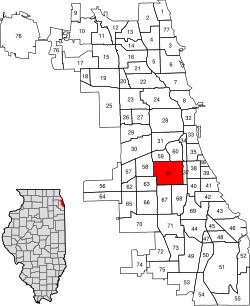Back of the Yards
|
New City Back of the Yards/Canaryville |
|
|---|---|
| Community area | |
| Community Area 61 - New City | |
|
at Exchange Ave
|
|
 Location within the city of Chicago |
|
| Coordinates: 41°48.6′N 87°39.6′W / 41.8100°N 87.6600°WCoordinates: 41°48.6′N 87°39.6′W / 41.8100°N 87.6600°W | |
| Country | United States |
| State | Illinois |
| County | Cook |
| City | Chicago |
| Neighborhoods |
list
|
| Area | |
| • Total | 4.86 sq mi (12.59 km2) |
| Population (2010) | |
| • Total | 44,377 |
| • Density | 9,100/sq mi (3,500/km2) |
| Demographics 2010 | |
| • White | 10.58% |
| • Black | 29.63% |
| • Hispanic | 57.31% |
| • Asian | 1.64% |
| • Other | 0.84% |
| Time zone | CST (UTC−6) |
| • Summer (DST) | CDT (UTC−5) |
| Zip Code | part of 60609 |
| Median income | $25,647 |
| Source: U.S. Census, Record Information Services | |
New City is one of Chicago's 77 official community areas, located on the southwest side of the city in the South Side district. It contains the neighborhoods of Canaryville and Back of the Yards.
The area was home to the famous that were on Chicago's south side until closed in 1971.
Back of the Yards is an industrial and residential neighborhood so named because it was near the former , which employed thousands of European immigrants in the early 20th century. Life in this neighborhood was explored in Upton Sinclair's 1906 novel The Jungle. The area was formerly part of the town of Lake until it was annexed by Chicago in 1889. In the late 19th and early 20th centuries, the area was occupied largely by Eastern European immigrants and their descendants, who were predominantly ethnic Bohemian, Moravian, and Slovak (from Hungary).
In the 1930s the activist Saul Alinsky did community organizing in this area, as its people suffered during the Great Depression. This work led to his founding the Industrial Areas Foundation in 1940, which trained community organizers.
Jane Jacobs in her 1961 book, The Death and Life of Great American Cities, cites the Back of the Yards as an area able to "unslum" in the 1960s, due to a beneficial set of circumstances. This included a stabilized community base with skilled members who were willing to trade work to upgrade housing, as well as active and well-led local social and political organizations. Jacobs often cited the Back of the Yards as a model for other depressed neighborhoods to follow to upgrade their communities.
Some time after the 1970s, when the stockyard operations closed and the number of nearby jobs decreased, many people left to move to newer housing and work in the suburbs. The population of the neighborhood gradually reflected a new wave of settlement, predominantly Mexican-American.
...
Wikipedia
